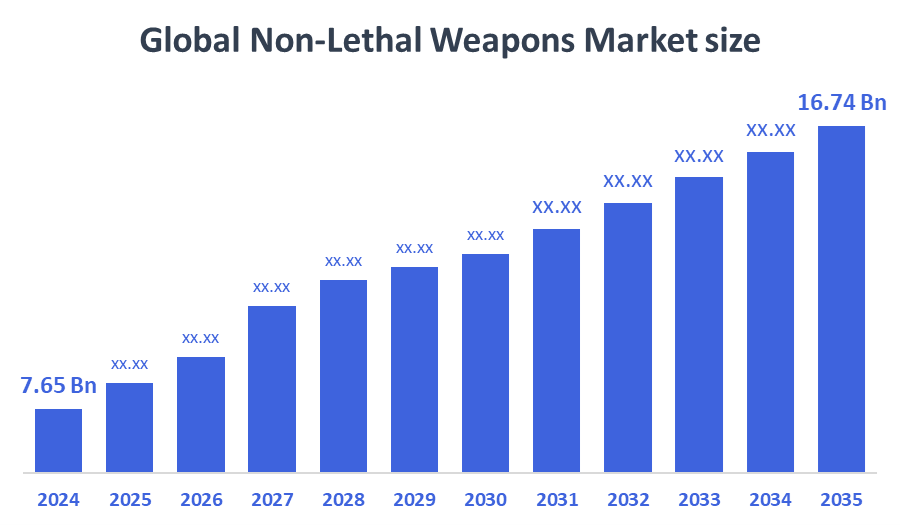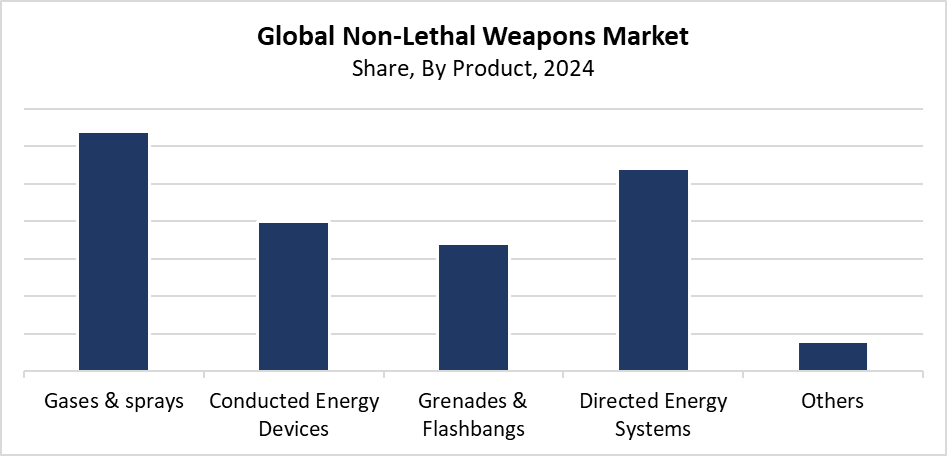Global Non-Lethal Weapons Market
Global Non-Lethal Weapons Market Size, Share, and COVID-19 Impact Analysis, By Product (Gases & sprays, Conducted Energy Devices, Grenades & Flashbangs, Directed Energy Systems, Others), By End Use (Civil & Commercial, Defense), and By Region (North America, Europe, Asia-Pacific, Latin America, Middle East, and Africa), Analysis and Forecast 2025 - 2035
Report Overview
Table of Contents
Non-Lethal Weapons Market Summary
The Global Non-Lethal Weapons Market Size Was Estimated at USD 7.65 Billion in 2024 and is Projected to Reach USD 16.74 Billion by 2035, Growing at a CAGR of 7.38% from 2025 to 2035. The market for non-lethal weapons is expanding as a result of growing demands for safer crowd control and defensive options, more civil disturbances, increased law enforcement requirements, a focus on reducing deaths, technological improvements, and growing security concerns worldwide.

Key Regional and Segment-Wise Insights
- In 2024, the North American non-lethal weapons market held the largest revenue share of 32.4% and dominated the global market.
- In 2024, the gases & sprays segment held the highest revenue share of 32.6% and dominated the global market by product.
- With the biggest revenue share of 67.5% in 2024, the defense segment led the worldwide market by end use.
Global Market Forecast and Revenue Outlook
- 2024 Market Size: USD 7.65 Billion
- 2035 Projected Market Size: USD 16.74 Billion
- CAGR (2025-2035): 7.38%
- North America: Largest Market in 2024
The market for non-lethal weapons provides multiple tools which aim to stop people while avoiding major injuries. The weapons primarily serve law enforcement and military forces, together with security personnel who use them for crowd control, self-defence, and riot suppression. These weapons consist of tasers, rubber bullets, pepper sprays, stun guns, and sonic devices. The industry experiences growth because of mounting global security threats and rising civil unrest, and military operations that aim to minimise combatant deaths. The market growth has occurred because of requirements for secure police equipment and the need to balance human rights with operational control.
The non-lethal weapons market experiences major changes from technological progress because electroshock devices have improved, and precision acoustic systems and advanced chemical agents have become more effective and safe. The devices now offer more functions because they connect with smart technology systems, which allow users to activate devices remotely. They track their status from a distance. The entire world government system has established strict rules which promote non-lethal measures to reduce violent incidents. Multiple defence and security organisations allocate resources to research and development because their funding and policy systems support non-lethal weapon deployment for law enforcement transformation.
Product Insights

The gases & sprays segment led the non-lethal weapons market with the largest revenue share of 32.6% in 2024. The widespread use of chemical agents, including pepper spray, tear gas, and crowd control for self-defence as well as law enforcement activities, has resulted in this situation. These products maintain their preference status because they provide straightforward operation and deliver quick opponent incapacitation while producing minimal risk of permanent harm. The need for these non-lethal alternatives has increased due to the rise in riots, protests, and other public unrest around the world. The gases and sprays serve a broad user base, which includes law enforcement officers, security personnel, and regular citizens, because they are inexpensive and easy to carry and need minimal training. The company maintains market leadership through its proven ability to reduce casualties while keeping control of situations.
The directed energy systems segment within the non-lethal weapons market is anticipated to grow at the fastest CAGR during the forecast period. The industry expansion stems from the development of laser, microwave, and acoustic systems that enable precise, scalable, and backward capabilities to disable objects at a distance. Directed energy weapons provide superior control, reduced collateral damage, and enhanced safety compared to traditional non-lethal weapons. The implementation of these systems moves forward because defence modernisation programs fund them. Security threats multiply, and because they must handle both large groups of people and protect boundaries. The market growth continues to surge because ongoing research works to improve directed energy weapons' portability, precision, and range capabilities for law enforcement and military operations.
End Use Insights
The defence segment held the largest revenue share of 67.5% and led the non-lethal weapons market in 2024. Armed forces continue to use non-lethal weapons for border security, peacekeeping operations, and situations where they need to reduce casualties. Defence agencies now focus on crowd control and conflict de-escalation tactics as their main priorities because they need these skills for urban warfare and humanitarian operations. The defence sector has accelerated its adoption of non-lethal technologies. Human rights standards and international humanitarian regulations have become more important. The world governments allocate their defence spending toward non-lethal mission effectiveness solutions to protect civilians from harm.
The civil and commercial segment of the non-lethal weapons market is expected to grow at the fastest CAGR throughout the forecast period. The market growth results from three main factors, which include rising civil unrest, increasing public safety concerns, and expanding requirements for effective crowd management solutions in public spaces. Security agencies and private security companies, and individual users, now rely on non-lethal weapons such as pepper sprays, stun guns, and acoustic devices for protection and to uphold compliance. The demand for non-lethal weapons continues to increase because these tools find applications in transportation operations, event management, and essential infrastructure security. The market expansion results from rising public knowledge about non-lethal weapons.
Regional Insights
North America dominated the non-lethal weapons market worldwide in 2024 with the largest revenue share of 32.4%. The United States and Canada lead this position because they invest heavily in defence and law enforcement while dedicating substantial resources to modernising their security equipment. The region's law enforcement agencies use non-lethal weapons for everyday policing and crowd control, and riot management to protect public safety and reduce harm to people. The market thrives because of increased research and development activities, together with supportive regulations and technological progress. The commercial and civil sectors of North America maintain market dominance because personal security needs have grown and civil disturbances have become more frequent. This drives up demand for non-lethal weapons.
Asia Pacific Non-Lethal Weapons Market Trends
The Asia Pacific non-lethal weapons market experiences significant growth because crime rates rise, political instability occurs, and authorities need effective methods to manage large groups of people. China, India, and South Korea direct their funds toward armed forces and police forces to acquire new non-lethal technologies for managing protests and border conflicts, and internal security threats. The growing urban population, together with frequent public demonstrations in major cities, has created a need for public safety solutions which use non-lethal methods to minimise casualties. The market growth accelerates because government initiatives back this sector. Defence budgets grow, and people become more familiar with non-lethal solutions. The region has increased its worldwide market share in non-lethal weapons because of technological progress and domestic manufacturing capabilities.
Europe Non-Lethal Weapons Market Trends
The European non-lethal weapons market is growing at a substantial rate because of increasing security demands, which result from rising civil unrest and public protests throughout the region. Law enforcement agencies use non-lethal weapons such as rubber bullets, tear gas, and shock guns to manage crowds and maintain public order while protecting human rights. The police and military forces of France, Germany, and the United Kingdom undergo modernisation through the implementation of non-lethal technology. The European Union supports market expansion because it requires ethical policing and non-lethal conflict solutions in its member states. The European non-lethal weapons industry experiences growth because technological progress aligns with regulations that support peaceful applications.
Key Non-Lethal Weapons Companies:
The following are the leading companies in the Non-lethal weapons market. These companies collectively hold the largest market share and dictate industry trends.
- NonLethal Technologies, Inc.
- TASER Self Defense
- SABRE
- Zarc International Inc.
- Byrna
- Mace
- Axon
- CONDOR
- Combined Systems, Inc.
- Armament Systems and Procedures
- Others
Recent Developments
- In June 2025, A new pepper spray product line called Defender LE was introduced by Armament Systems & Procedures (ASP) with an eye toward law enforcement.
- In February 2025, CONDOR, an entity of the EDGE Group (UAE), and SENAPPEN, a Brazilian organisation, signed a deal to improve jail security in Brazil through training and non-lethal technology (NLT).
Market Segment
This study forecasts revenue at global, regional, and country levels from 2020 to 2035. Decision Advisors has segmented the non-lethal weapons market based on the below-mentioned segments:
Global Non-Lethal Weapons Market, By Product
- Gases & sprays
- Conducted Energy Devices
- Grenades & Flashbangs
- Directed Energy Systems
- Others
Global Non-Lethal Weapons Market, By End Use
- Civil & Commercial
- Defense
Global Non-Lethal Weapons Market, By Regional Analysis
- North America
- US
- Canada
- Mexico
- Europe
- Germany
- UK
- France
- Italy
- Spain
- Russia
- Rest of Europe
- Asia Pacific
- China
- Japan
- India
- South Korea
- Australia
- Rest of Asia Pacific
- South America
- Brazil
- Argentina
- Rest of South America
- Middle East & Africa
- UAE
- Saudi Arabia
- Qatar
- South Africa
- Rest of the Middle East & Africa
Check Licence
Choose the plan that fits you best: Single User, Multi-User, or Enterprise solutions tailored for your needs.
We Have You Covered
- 24/7 Analyst Support
- Clients Across the Globe
- Tailored Insights
- Technology Tracking
- Competitive Intelligence
- Custom Research
- Syndicated Market Studies
- Market Overview
- Market Segmentation
- Growth Drivers
- Market Opportunities
- Regulatory Insights
- Innovation & Sustainability
Report Details
| Pages | 220 |
| Delivery | PDF & Excel via Email |
| Language | English |
| Release | Oct 2025 |
| Access | Download from this page |
